Trees Birds Mammals Fish Amphibians Reptiles
Wild Algarve
Bookshop
Lepiota oreadiformis Velen.
Phylum: Basidiomycota - Class: Agaricomycetes - Order: Agaricales - Family: Agaricaceae
Distribution - Taxonomic History - Etymology - Identification - Toxicity - Reference Sources
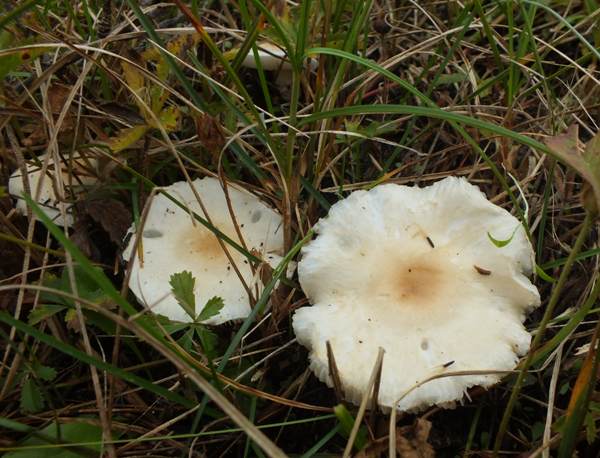
Dapper sometimes, but more often entangled in sand-dune vegetation such as Marram, this pale dapperling is an uncommon find; however, where it does occur it is often gregarious.
Several other Lepiota species have pale caps, darker towards the centre, but as the scientific name implies this one has a low umbo not unlike that of the Fairy-ring Champignon Marasmius oreades.
Distribution
Rather an uncommon find in sandy semi-natural grasslands, most particularly therefore near to the coast, this dapperling is rarely seen in the north of Britain and Ireland. Lepiota oreadiformis occurs also in many parts of mainland Europe including France, where the specimens shown on this page were found, and the Netherlands. This pretty dapperling has also been recorded, but very few times and in one or two locations only, in North America.
Taxonomic history
This mushroom was described in 1920 by Czech mycologist Josef Velenovský (1858 - 1949), who gave it the binomial scientific name Lepiota oreadiformis.
Synonyms of Lepiota oreadiformis include Agaricus clypeolarius var. pratensis Bull., Lepiota clypeolaria var. pratensis (Bull.) Gillet, Lepiota pratensis (Bull.) Bigeard & H. Guill., Lepiota gracilis var. laevigata J.E. Lange, Lepiota laevigata (J.E. Lange) J.E. Lange, and Lepiota oreadiformis var. laevigata (J.E. Lange) Bon.
Etymology
Lepiota, the genus name, comes from Greek words Lepis, meaning scale, and ot, meaning ear. Scaly ear fungus is an interpretation, therefore. Scales on a convex (vaguely ear-shaped) cap are characteristic of most fungi in this genus, as also are free gills and a stem ring.
The origin of the specific epithet oreades are the Oreads or Oreiades, nymphs (in Greek mythology) of mountains, valleys and ravines - all of which are places where Fairy-ring Champignons Marasmius oreades might be found, but although Lepiota oreadiformis is in form (hence -iformis) rather like M. oreades it is far less ubiquitous, being found mainly in sandy grassland.
Identification guide
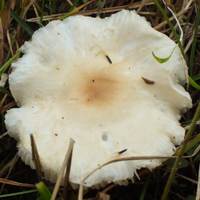 |
Cap
Initially hemispherical, becoming convex and flattening with a slight umbo; white with a reddish-brown smooth (not noticeably scaly) centre; margin whitish, usually slightly floccose.
Cap diameter at maturity ranges from 2 to 6cm. |
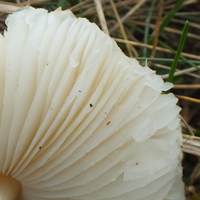 |
Gills
The moderately spaced gills are greyish white or greyish cream when young, developing a slight pinkish tinge at maturity; they terminate free of the stem. |
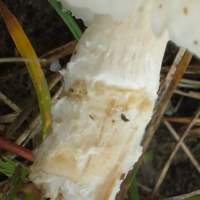 |
Stem
Creamy white; 3 to 7cm long and 3 to 6mm diameter; cylindrical, sometimes broadening slightly towards the base; longitudinally fibrillose above a weakly-developed superior ring (or at least a ring zone); with irregular and sparse woolly pale yellowish-brown floccules below the ring zone, |
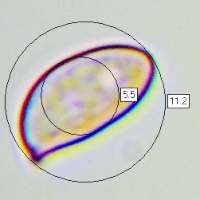 |
Spores
Fusiform to amygdaloid, smooth, thick walled, 10-16 x 4.5-6.5μm; dextrinoid.
Spore print
White. |
Odour/taste |
Not significant. |
Habitat & Ecological role |
Saprobic, solitary or in small groups mainly in unimproved calcareous grassland, most often on sandy soil. |
Season |
June to September in Britain and Ireland. |
Similar species |
Lepiota ignivolvata has a bright orange or red-brown ring low down on the stem.
Lepiota cristata orange-brown scales on its cap and has an unpleasant odour. |
Toxicity
Lepiota oreadiformis is generally regarded as inedible. In my opinion there are no dapperlings worth collecting to eat, particularly because confident identification in the field is very difficult and several of them are seriously toxic toadstools. For example, Lepiota cristata the Stinking Dapperling is poisonous and could be mistaken for a small edible Parasol Mushroom Macrolepiota procera. If what you believe to be Parasols are smaller than 10cm in cap diameter then check very carefully, because it is possible that they are actually poisonous Lepiota species.
Reference Sources
Fascinated by Fungi, 2nd Edition, Pat O'Reilly 2016, reprinted by Coch-y-bonddu Books in 2022.
Funga Nordica: 2nd edition 2012. Edited by Knudsen, H. & Vesterholt, J. ISBN 9788798396130
British Mycological Society. English Names for Fungi
Dictionary of the Fungi; Paul M. Kirk, Paul F. Cannon, David W. Minter and J. A. Stalpers; CABI, 2008
Taxonomic history and synonym information on these pages is drawn from many sources but in particular from the British Mycological Society's GB Checklist of Fungi.
Acknowledgements
This page includes pictures kindly contributed by Simon Harding.
Top of page...
Fascinated by Fungi. Back by popular demand, Pat O'Reilly's best-selling 450-page hardback book is available now. The latest second edition was republished with a sparkling new cover design in September 2022 by Coch-y-Bonddu Books. Full details and copies are available from the publisher's online bookshop...